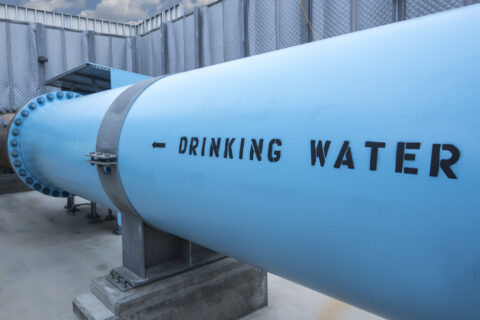If you are a local government leader who has looked for federal infrastructure funding, you’ve seen the term “NEPA” in the terms and requirements under these programs.
This abbreviation refers to the National Environmental Policy Act (NEPA), which became law in 1970 and requires federal agencies to assess the potential environmental impacts of a proposed federally funded infrastructure project. It is the primary law governing environmental review processes for all federal agencies through an established decision-making process agencies must follow.
Each federal agency has NEPA procedures and responsibilities consistent with the regulations issued by the Council on Environmental Quality. Federal agencies are responsible for overseeing these procedures and managing the environmental review process for projects that receive financial assistance from their agency.
Once local governments have been awarded federal infrastructure program funding, they are responsible for completing the steps in the environmental review process through the awarding agency’s procedures. As project winners, local governments are co-leads in completing the environmental review process for their project with the federal agency, which typically must be completed before federal funds are dispersed to the local government.
While there may be some exceptions per program, the NEPA environmental review process steps are usually not eligible uses of the federal construction program funds and must be completed in advance of the disbursement of federal funds.
NLC encourages local governments who have won federal infrastructure awards or are applying to federal infrastructure programs to familiarize themselves with the NEPA environmental review process.
There are different classifications and levels of environmental review that each agency has defined. Check out agency resources below to learn more about the NEPA requirements for your community’s transportation, water and broadband projects.
NEPA Resources from Federal Agencies by Project Type
Highway/Road Projects
- Federal Highway Administration Environmental Review Toolkit Resources – The toolkit provides NEPA guidance, including sections on environmental justice, historic preservation, planning and environmental linkages, public input and the Bipartisan Infrastructure Law.
- Federal Highway Administration Implementing Procedures – This breaks down the laws and regulations, guidance and resources for assisting federal agencies in implementing the environmental policy and provisions of NEPA that grant awardees need to follow.
- National Highway Institute Introduction to NEPA and Transportation Decision-making course – The National Highway Institute offers a free online course (over 8 hours) that introduces NEPA and the implementing regulations. Participants will be able to understand the basics of NEPA and FHWA’s approach to their decision-making process.
- The Federal Transit Administration offers additional environmental training and technical assistance. This includes recorded webinars and training videos and in-person courses. The National Transit Institute offers web-based courses including NEPA 101 and an Environmental and Sustainability Management Systems (ESMS) intro.
Port/Maritime Projects
- MARAD’s NEPA Guidance – The Maritime Administration outlines procedures for considering environmental impacts. Included in the resource is a categorial exclusion checklist for related projects.
Transit Projects
- Federal Transit Authority Environmental Review Process – The Federal Transit Authority (FTA) has a webpage focused on the environmental review process for their agency.
- Federal Transit Authority Preparing Environmental Documents Procedures – FTA also breaks down the three levels of environmental review and documentation under NEPA into three classes of action, which determine how compliance with NEPA is carried out and documented.
Rail Projects
- Federal Rail Administration Environmental Procedures – Learn more about Federal Rail Administration (FRA) environmental reviews, including a table of environmental assessments/environmental impact statements per NEPA regulations.
- Federal Rail Administration Categorical Exclusions – The FRA also provides a categorical exclusion worksheet.
Water Projects
The U.S. Environmental Protection Agency (EPA) is required to comply with the requirements of NEPA for facilities construction, wastewater treatment construction grants under Section 201 of the Clean Water Act, water and wastewater infrastructure projects under the Water Infrastructure Finance and Innovation Act (WIFIA), National Pollutant Discharge Elimination System (NPDES) permits for “new sources” and certain projects funded through the EPA in the annual appropriations acts.
- WIFIA Federal Compliance Requirements – Projects that receive Water Infrastructure Finance and Innovation Act credit assistance must comply with the EPA compliance for federal requirements under NEPA. This guide is designed to aid prospective and current bowers navigating the various federal requirements under the program. Page 2 of the guidebook starts the section on environmental authorities specific to NEPA.
- NPDES Permit Program – Permits under the National Pollutant Discharge Elimination System are also subject to NEPA regulations. Section 511 of the Clean Water Act establishes that only EPA-issued permits to “new sources (meaning dischargers subject to new source performance standards) are subject to the NEPA environmental review procedures prior to permit issuance. This link will take readers to an EPA webpage that overviews the NEPA process and the three different levels of analysis.
Broadband Projects
The applicability of NEPA to communications infrastructure varies between wireline (such as fiber or cable) infrastructure and wireless infrastructure, as well as between specific types of wireless infrastructure. For example, while construction of many types of wireless broadband infrastructure is subject to environmental assessment requirements, certain types of wireless infrastructure have been excluded from NEPA. Some small wireless facilities and collocations of equipment or modifications of existing towers or other wireless communications infrastructure are generally exempted from NEPA requirements.
- Environmental and Historic Preservation Requirements for Wireless Facilities – The Federal Communications Commission provides information on the federal environmental and historic preservation requirements that may need to be addressed prior to construction of wireless communications facilities. The FCC also held a workshop on these requirements in September 2022.
- NTIA NEPA, NHPA and Permitting Resources – The National Telecommunications and Information Administration held workshops on NEPA and historic preservation requirements and the permitting process for broadband infrastructure in 2022.
Local governments often find the NEPA process to be cumbersome and inefficient, with administrative burdens often overwhelming for communities. The recently enacted Fiscal Responsibility Act to extend the debit limit includes some provisions to streamline and improve the NEPA process to be less cumbersome and more time-efficient to help move local infrastructure projects along.















